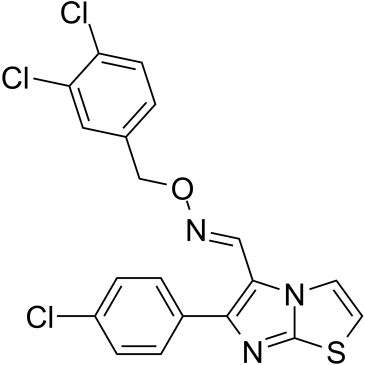CITCO

CITCO structure
|
Common Name | CITCO | ||
|---|---|---|---|---|
| CAS Number | 338404-52-7 | Molecular Weight | 436.74200 | |
| Density | 1.48g/cm3 | Boiling Point | N/A | |
| Molecular Formula | C19H12Cl3N3OS | Melting Point | N/A | |
| MSDS | Chinese USA | Flash Point | N/A | |
| Symbol |

GHS07 |
Signal Word | Warning | |
Use of CITCOCITCO, an imidazothiazole derivative, is a selective Constitutive androstane receptor (CAR) agonist. CITCO inhibits growth and expansion of brain tumour stem cells (BTSCs) and has an EC50 of 49 nM over pregnane X receptor (PXR), and no activity on other nuclear receptors[1]. |
| Name | (E)-1-[6-(4-chlorophenyl)imidazo[2,1-b][1,3]thiazol-5-yl]-N-[(3,4-dichlorophenyl)methoxy]methanimine |
|---|---|
| Synonym | More Synonyms |
| Description | CITCO, an imidazothiazole derivative, is a selective Constitutive androstane receptor (CAR) agonist. CITCO inhibits growth and expansion of brain tumour stem cells (BTSCs) and has an EC50 of 49 nM over pregnane X receptor (PXR), and no activity on other nuclear receptors[1]. |
|---|---|
| Related Catalog | |
| Target |
CAR, PXR[1] |
| In Vitro | CITCO (1-50 μM; 48 hours) results in a dose-dependent inhibition of viable cell count and proliferation in both T98G and U87MG glioma and BTSCs[1]. CITCO (2.5, 5 μM; 48 hours) induces cell cycle arrest differentially in different BTSCs in culture, but not in normal astrocytes[1]. CITCO (2.5-10 μM; 48 hours) induces apoptosis in BTSCs in culture in dose dependently, but not in normal astrocytes[1]. CITCO (0-25 μM; 48 hours) causes the T98G and U87MG glioma and BTSCs expressing very low levels of CAR protein that increased significantly[1]. Cell Proliferation Assay[1] Cell Line: T98G, U87MG, DB29 and DB33 human glioma cells, astrocytes Concentration: 1, 2.5, 5, 10, 25, 50 μM Incubation Time: 48 hours Result: Resulted in a dose-dependent inhibition of viable cell count and proliferation. Cell Cycle Analysis[1] Cell Line: The T98G, U87MG, DB29 and DB33 glioma cells Concentration: 2.5, 5 μM Incubation Time: 48 hours Result: Induced cell cycle arrest differentially in different BTSCs in culture. Apoptosis Analysis[1] Cell Line: The T98G, U87MG, DB29 and DB33 glioma cells Concentration: 2.5, 5 or 10 μM Incubation Time: 48 hours Result: Increased the levels of Annexin V-positive apoptotic cells in dose dependently. Western Blot Analysis[1] Cell Line: T98G, U87MG, DB29 and DB33 glioma cells Concentration: 0 to 25 μM Incubation Time: 48 hours Result: The T98G, U87MG glioma and BTSCs expressed very low levels of CAR protein that increased significantly. |
| In Vivo | CITCO (intraperitoneal; on days 22, 24, 26, 30 and 36) with 25 μg results a significant decrease in tumour growth, which further decreases to an undetectable level after treatment with 100 μg CITCO [1]. Animal Model: Six- to eight-week-old male athymic nude mice[1] Dosage: 25 or 100 μg Administration: Intraperitoneal; on days 22, 24, 26, 30 and 36 Result: Decreased tumour growth. |
| References |
| Density | 1.48g/cm3 |
|---|---|
| Molecular Formula | C19H12Cl3N3OS |
| Molecular Weight | 436.74200 |
| Exact Mass | 434.97700 |
| PSA | 67.13000 |
| LogP | 6.57370 |
| Index of Refraction | 1.697 |
| InChIKey | ZQWBOKJVVYNKTL-UHFFFAOYSA-N |
| SMILES | Clc1ccc(-c2nc3sccn3c2C=NOCc2ccc(Cl)c(Cl)c2)cc1 |
| Symbol |

GHS07 |
|---|---|
| Signal Word | Warning |
| Hazard Statements | H315-H319-H335 |
| Precautionary Statements | P261-P305 + P351 + P338 |
| Personal Protective Equipment | dust mask type N95 (US);Eyeshields;Gloves |
| Hazard Codes | Xi: Irritant; |
| Risk Phrases | 36/37/38 |
| Safety Phrases | 26-36 |
| RIDADR | NONH for all modes of transport |
|
Evaluation of the HC-04 cell line as an in vitro model for mechanistic assessment of changes in hepatic cytochrome P450 3A during adenovirus infection.
Drug Metab. Dispos. 42(7) , 1191-201, (2014) HC-04 cells were evaluated as an in vitro model for mechanistic study of changes in the function of hepatic CYP3A during virus infection. Similar to in vivo observations, infection with a first genera... |
|
|
Involvement of CAR and PXR in the transcriptional regulation of CYP2B6 gene expression by ingredients from herbal medicines.
Xenobiotica 45 , 773-81, (2015) 1. Induction of hepatic drug-metabolizing enzymes can affect drug efficacy and cause toxicity. However, so far, limited information is available regarding the molecular mechanism how herbal medicines ... |
|
|
Quantitative high-throughput identification of drugs as modulators of human constitutive androstane receptor.
Sci. Rep. 5 , 10405, (2015) The constitutive androstane receptor (CAR, NR1I3) plays a key role in governing the transcription of numerous hepatic genes that involve xenobiotic metabolism/clearance, energy homeostasis, and cell p... |
| 6-(4-CHLOROPHENYL)IMIDAZO[2,1-B][1,3]THIAZOLE-5-CARBALDEHYDE O-(3,4-DICHLOROBENZYL)OXIME |
| 6-(4-Chlorophenyl)imidazo[2,1-b][1,3]thiazole-5-carbaldehyde O-(3,4-dichlorobenzyl)oxime |
| CITCO |